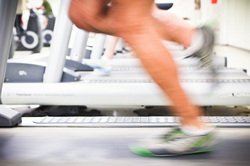
A new term used by fitness experts to describe people like my mom, or those who fail to see results from typical workout routines, is "exercise nonresponders."
Personally, I don't care much for this term. It sounds like they are blaming the person, rather than the workout, when in fact, there is a lot of new research that shows that the type of workout you do actually has a lot to do with your results (or lack of them).
If you've experienced the frustration of not achieving the results you want through your workouts, this might be the reason...
The results were based on measuring heart rate and lung capacity, both before and after 3 weeks of endurance training, followed by 3 weeks of high-intensity interval training (HIIT).
However, there is quite a bit of evidence showing that the human body simply was not designed for this type of exercise. Endurance exercise such as long, drawn-out cardio has actually been shown to reduce lung power and put too much stress on your heart, joints, and more. (This may be one reason why you often hear of professional long-distance runners dying young.)
In fact, The 2003 Harvard Health Professionals Study of over 7,000 people found that the key to effective exercise is not length or endurance - but intensity. The more energy a person exerted during exercise, the lower their risk of heart disease.(2) And in a previous study published in 1995 in the Journal of the American Medical Association, exercise intensity was found to reduce risk of death and improve longevity in men.(3)
Okay, so if intensity is the key, then why didn't the HIIT workouts work, either?
One possibility that has been proposed by Dr. Al Sears, MD, is simply that high-intensity interval training workouts are too extreme for the average American, who really isn't ready for such intense workouts right off the bat (or in this case, right off the couch). Instead Dr. Sears proposes an interesting approach to exercise that he calls Progressively Accelerating Cardiopulmonary Exertion (PACE).
PACE , in Dr. Sears' words, "uses brief but vigorous routines of increasing intensity to help build the strength and capacity of your heart and lungs."
Basically you start at your current fitness level - no matter what that level is - and you slowly and gradually increase the intensity and the challenge over time, at your own pace. This means that theoretically anyone, of any fitness level or health condition, can do PACE. It works no matter where you start - as long as you progressively challenge your maximum exertion.
And Dr. Sears claims to have seen some pretty amazing results:
"After only a few weeks of doing PACE, even my oldest patients soon develop the lungpower of much younger people — even those who have been diagnosed with heart disease! In fact, I have never seen a patient who did not improve their fitness… lose weight… build muscle… increase their lung capacity… and more with PACE. In other words, for people who do PACE, there's no such thing as a 'nonresponder.'"
The cool thing about PACE is, because it focuses on intensity of exercise rather than length, you can actually accomplish an effective workout that gets results in less than 15 minutes per day - and you don't need any expensive gym equipment to do it - all you need is your own body, and some space to work out in.
I've been using one of Dr. Sears' workout programs - a DVD set called PACE Express for a few years now - and now my husband (a self-avowed workout hater) is doing it too! He likes it just because he can get a full workout in in just 15 minutes, and I like it because it makes me sweat and feel like I really accomplished something with my body, I don't have to spend a ton of time working out, and the variety of exercises keeps it from getting boring (plus I can see on the countdown clock on the video how many seconds I have left, so it makes it doable to complete an intense set). :-)
Being as busy as I am, I rarely have time to spend more than 1/2 hour working out (if that), so something like PACE really fits my busy lifestyle.
You can learn more about PACE Express here if you like...
But stay tuned, as I have a FREE goodie coming for you next week that may also help! It's something I put together for you myself, and it's designed for busy people who wish they were in better shape, but just can't seem to find the time to work out regularly. Be sure to check back next week to grab your copy of this valuable new resource for free - I think you'll really like it! :-)
Until then, live healthy!
Rose.
Sources:
1.) Bonafiglia JT, Rotundo MP, Whittall JP, et al. "Inter-Individual Variability in the Adaptive Responses to Endurance and Sprint Interval Training: A Randomized Crossover Study." Calbet JAL, ed. PLoS ONE. 2016;11(12):e0167790.
2.) Lee I, et al. Relative intensity of physical activity and risk of coronary heart disease. Circulation. 2003;107(8):1110-6.
3.) Lee I, et al. "Exercise intensity and longevity in men. The Harvard Alumni Health Study." JAMA. 1995 Apr 19;273(15):1179-84.



 RSS Feed
RSS Feed